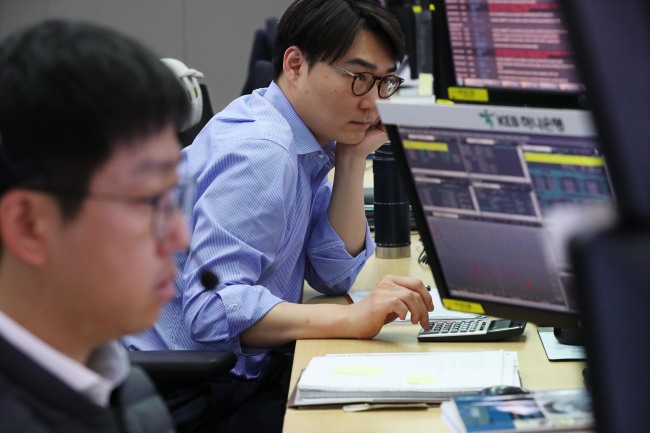Korea is unlikely to be significantly affected by the spreading financial instability in emerging market countries but it must not let its guard down, analysts say.
There are growing concerns that capital outflow from emerging economies with weak fundamentals will accelerate in the coming months, as they are being hit by the strengthening of the dollar amid the rise in US interest rates and oil prices.
Prompted by the prospect that low unemployment and high oil prices will push inflation above its target of 2 percent, the US Federal Reserve is expected to raise its policy rate by a quarter percentage point next month for the second time this year to a range of 1.75 percent to 2 percent.
The move would heighten the expectation that the key US rate will be raised up to four times in 2018, sending the value of the greenback further higher against the currencies of most emerging market countries.
The dollar appreciated 8.2 percent against the Argentine peso, 7.1 percent against the Turkish lira, 6.9 percent against the Brazilian real and 6.6 percent against the Mexican peso from end-March to May 7, according to data from the Bank of Korea.
The rapid outflow of foreign capital from Argentina made Latin America’s third-largest economy ask for emergency loans from the International Monetary Fund last week.
Money is also flooding out of Turkey and Indonesia, heightening concerns that the currency crisis will spread across emerging economies, which are saddled with an estimated $2 trillion in dollar-denominated foreign debt, according to the Bank for International Settlements.
The Korea Center for International Finance, a local think tank, noted global investors have pulled money out of emerging economies in recent weeks at a more rapid pace than during the 2013 taper tantrum sparked by concerns over the tightening of US monetary policy.
According to its estimate, foreign investors have collected $5.5 billion from emerging markets since mid-April.
Most analysts here see little chances of Korea being significantly affected by the emerging market turbulence, given it has piled up current account surpluses and kept public debt at a relatively low level.
The Korean won remains relatively stable, losing a mere 1.3 percent in its value against the dollar over the period from end-March to May 7.
As of the end of 2017, Korea’s foreign exchange reserves stood at $389.2 billion, compared with Argentina’s $45 billion.
“The impact of a possible capital flight on the country would be limited, considering its large currency reserves,” said Shin Hwan-Jong, an analyst at NH Investment and Securities.
But a continuous net selling of Korean shares by foreign investors has worried market watchers.
Offshore investors, who bought a net 1.97 trillion won ($1.84 billion) of local stocks in January, have since turned to net sellers. The net selling amounted to 1.56 trillion won in February, 740.9 billion won in March and 1.03 trillion won in April, according to figures from Korea Exchange.
The rise in US Treasury bill rates and concerns over emerging market instability have recently precipitated the pace of selling, with investors selling a net 813.6 billion won of Korean shares during the first six trading days of May.
“There is the possibility that local financial markets will become unstable, though not so severely as the foreign exchange crisis in the late 1990s,” said Choi Bae-geun, a professor of economics at Konkuk University.
He noted the spread of emerging market turbulence could have a negative effect on Korea’s outbound shipments, undermining the earnings of local manufacturing exporters.
Concerns have been raised particularly over the possibility that a further widening of interest rate reversal between Korea and the US will prompt a massive capital outflow from the country. Currently, Korea’s base rate stands at 1.5 percent, the same as the low end of the US policy rate band.
A report released last week by the National Assembly Budget Office warned that if the interest rate gap widened to as large as 1 percentage point, the fallout could be consequential.
It indicated Korea suffered a net capital outflow of 8.2 trillion won from the local stock and bond markets between May and July 2006, when the rate gap between the country and the US was 1 percentage point. This translated into a monthly average of 2.7 trillion won, nearly three times the amount of capital outflow caused by the rate difference of 0.5 percentage point or below.
Korea’s benchmark stock price index plummeted as much as 8.6 percent during the three-month period.
“A wide rate gap could lead to an outflow of foreign investment funds, put downward pressure on the local bourse and weaken demand for Korean bonds, increasing the volatility of the domestic financial market,” the report said.
Market expectations are now growing that the BOK will move to raise its base rate by a quarter percentage point to 1.75 percent in July.
In what was interpreted by analysts as signaling a rate hike, BOK head Lee Ju-yeol said earlier this month that extended monetary easing could deepen “financial imbalance” when the economy continues to grow robustly.
By Kim Kyung-ho
([email protected])


